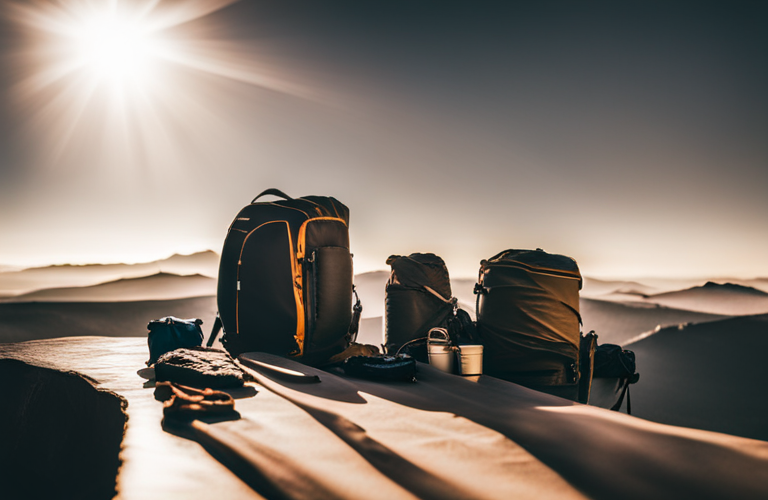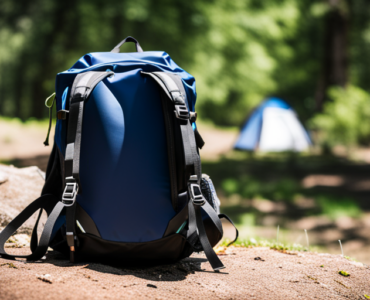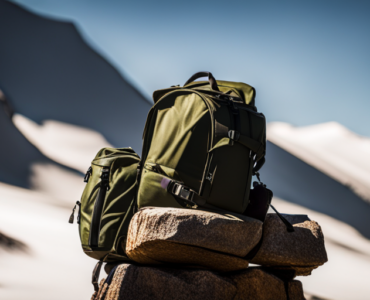Are you getting ready for an exciting camping trip? Well, then you've come to the right place! In this guide, I will walk you through the process of properly packing your camping backpack for an organized and efficient trip. It may seem overwhelming at first, but with a little planning, you can ensure that everything you need is neatly packed and easily accessible. So, let's dive in and get your backpack ready for an unforgettable adventure in the great outdoors!
Table of Contents
Quick Tips
Tip 1: Choose essential items – When packing your camping backpack, make sure to select only the most important items for your trip. Focus on necessities like a tent, sleeping bag, cooking utensils, and enough food and water to last the duration of your adventure.
Tip 2: Keep weight balanced – Distribute the weight evenly in your backpack to maintain stability while hiking. Place heavy items like your stove or cooking gear close to your back and lighter items towards the top and outer sides of the bag.
Tip 3: Use packing cubes – To stay organized, utilize packing cubes or smaller bags to categorize and group items like clothes, toiletries, and food. This way, everything has its place and can be easily located without having to rummage through your entire backpack.
Tip 4: Pack smart – Roll your clothes tightly instead of folding them to save space and reduce wrinkles. Place frequently used items like your flashlight or snacks in easily accessible exterior pockets. And remember, don't overpack – only take what you truly need to ensure a comfortable and enjoyable camping experience.
Utilize packing cubes or dry sacks to compartmentalize and protect gear
A packing cube or a dry sack can be your best friend for organizing your gear when you are going on a trip. These nifty little tools will help you compartmentalize your belongings and protect them from harm. To make the most out of these handy items, here are some step-by-step tips and tricks for you to follow.
First, start by gathering all the gear you plan to bring on your trip. Lay everything out on a clean, flat surface, and sort them into categories such as clothing, toiletries, electronics, and accessories. Once you have your categories set, it's time to choose the right size and quantity of packing cubes or dry sacks for each category. For example, you might need a larger cube for your clothes, a medium one for your toiletries, and smaller ones for your electronics and accessories.
Next, begin filling up each packing cube or dry sack with the appropriate items. Roll your clothes tightly to minimize wrinkles and maximize space efficiency. Stack them neatly inside the clothing cube, making sure not to overstuff it. For toiletries, place them in leak-proof plastic bags before placing them in the cube to protect your other belongings from any accidental spills. As for electronics and accessories, use smaller cubes or sacks to keep them organized and easily accessible.
Once everything is packed, it's time to put your packing cubes or dry sacks to use. Start by placing the larger cubes or sacks at the bottom of your suitcase or backpack, creating a solid foundation. Then, stack the smaller ones on top, making sure to distribute the weight evenly. This will help prevent any shifting or damage during transportation. Lastly, remember to label each cube or sack with its designated category to make unpacking and finding items a breeze once you reach your destination.
When traveling, use packing cubes or dry sacks to compartmentalize your gear and prevent leaks. This will not only keep everything organized, but will also save you time and energy. So next time you're preparing for a trip, remember these simple steps and enjoy the benefits of stress-free packing. Happy travels!
How to Pack Your Backpack the Right Way | Outside
Distribute weight evenly throughout the backpack for comfortable and balanced carrying
When you're going on a hike or heading to school, it's important to make sure you distribute the weight evenly throughout your backpack. This is what we call comfortable and balanced carrying. To achieve this, start by organizing your items before packing your bag. Place heavier items at the bottom of your backpack, closer to your back. This will keep the weight centered and prevent it from pulling you backwards or straining your shoulders.
Next, make use of the different compartments in your backpack. This will help you evenly distribute the weight and keep everything organized. Put smaller and lighter items in the front pockets or compartments, and place the larger and heavier items toward the back of your backpack. This way, the weight will be evenly distributed, and you won't feel any unnecessary strain on your body.
Finally, it's important to adjust the straps of your backpack to ensure a comfortable and balanced carrying experience. Start by tightening the shoulder straps. They should be snug against your shoulders but not cutting into your skin. If your backpack has a waist or chest strap, use these to secure the weight even further. These straps will help distribute the weight evenly and prevent your backpack from sagging or pulling you backward. By following these simple steps, you can enjoy a comfortable and well-balanced carrying experience, whether you're on a hike or getting ready for class.
Place frequently needed items near the top or in easily accessible pockets
When organizing your belongings, it's important to place frequently needed items near the top or in easily accessible pockets. This simple and practical step can save you time and frustration when searching for something you use on a regular basis. Imagine reaching into your bag and finding your keys, wallet, or phone right away, without having to dig through a cluttered mess. By keeping these essential items within arm's reach, you'll always know where they are and can grab them quickly when you need them.
Not only does placing frequently needed items near the top or in easily accessible pockets save you time, but it also helps keep your belongings organized and prevents them from getting misplaced. When items are scattered throughout your bag or tucked away in hard-to-reach compartments, it's easy for them to get lost or be overlooked. By intentionally designating specific spots for commonly used items, you create a system that becomes second nature to you. This way, you'll always know where to find your essentials and can easily access them whenever you need them.
To implement this organizational strategy, start by identifying the items that you use most frequently. These could be your keys, phone, wallet, or any other essential items that you reach for multiple times a day. Once you've identified them, find a designated spot near the top of your bag or in an easily accessible pocket where you can store these items. Consistently placing them in these designated areas will become a habit over time, making it effortless for you to access them when you need them. With this simple organizational trick, you'll be amazed at how much time and stress you can save by having your frequently needed items within arm's reach.
Create a detailed inventory list to stay organized and avoid forgetting essentials
Are you tired of forgetting important items when you go on a trip or organize an event? Well, I have a solution for you – create a detailed inventory list! This simple yet effective tool will not only help you stay organized, but also ensure that you never forget any essential items again. So let's dive into how you can create an inventory list that will be your trusty companion for staying organized.
First, start by making categories for the items you need to keep track of. For example, if you're going on a trip, you might have categories like clothing, toiletries, electronics, and documents. By organizing your items into categories, it will be easier for you to spot any missing essentials. Next, write down each item under its respective category. Be as specific as possible, noting down the quantities and any specific details about each item. For instance, instead of just writing “clothes,” specify the number of shirts, pants, and jackets you need to bring. This level of detail will help ensure that you don't leave anything behind.
Once you have your inventory list ready, make sure to check off each item as you pack or prepare for your trip or event. This step is crucial to ensuring that you have everything you need. As you pack each item, make a satisfying checkmark next to it. This simple action will not only give you a sense of accomplishment but also provide you with the assurance that you have packed everything necessary. By following this step-by-step process, you can be confident that you won't forget any essentials and stay organized for any occasion.
With a detailed inventory list in hand, you can say goodbye to the stress of forgetting important items. So next time you have a trip or event coming up, take a few minutes to create a comprehensive inventory list. By categorizing your items, noting down every detail, and checking off each item as you pack, you'll be on your way to a stress-free and organized experience. Happy packing!
Conclusion
To conclude, learning how to pack your camping backpack is crucial for ensuring a comfortable and balanced trip. Prioritizing essential items, using packing cubes or dry sacks, and distributing weight evenly will ensure a comfortable and balanced trip. This not only helps to protect your gear but also makes your camping adventure more enjoyable. By following these packing tips, you will save time, effort, and frustration on your next camping trip, allowing you to focus on enjoying the great outdoors and making memories that will last a lifetime. So why wait? Start implementing these strategies today and feel the difference it makes in improving your camping experience.
FAQ
Q: Why is it important to properly pack your camping backpack?
A: Properly packing your camping backpack ensures that you have everything you need for a comfortable and efficient trip. It helps distribute the weight evenly, prevents items from being damaged, and makes it easy to access essential items when needed.
Q: What are the essential items to pack in a camping backpack?
A: The essential items to pack in a camping backpack include a tent, sleeping bag, sleeping pad, cooking gear, food and water, hiking boots, clothing layers, toiletries, navigation tools, first-aid kit, and a flashlight. Additionally, pack any personal items you may need, such as medications or specific gear for activities like fishing or rock climbing.
Q: How should I prioritize packing my camping backpack?
A: Prioritize packing by placing heavier items at the bottom and closer to your back. This way, the weight is distributed evenly, and it will be easier to maintain balance while hiking. It is also important to pack frequently used items at the top or in external pockets for easy accessibility.
Q: How can I keep my backpack organized?
A: Use packing cubes or small zippered bags to compartmentalize and keep similar items together. Use separate bags for clothes, toiletries, food, and cooking gear. Consider using color-coded bags or labels to easily identify each item. Don't forget to pack a trash bag to keep your backpack clean and organized throughout the trip.
Q: Are there any specific techniques to pack my backpack efficiently?
A: Yes, here are a few techniques to pack your backpack efficiently:
1. Roll clothes instead of folding them to save space.
2. Store small items inside shoes or unused spaces within your backpack.
3. Keep frequently used items (like snacks or a raincoat) easily accessible by packing them in external pockets or the top lid of your backpack.
4. Attach bulky items like a sleeping pad or tent to the outside of your backpack using straps.
5. Distribute weight evenly by balancing heavier items on both sides of the backpack.
Q: How much weight should I aim for in my backpack?
A: As a general rule of thumb, try to keep your backpack's weight between 20-30% of your body weight. However, it's essential to consider your familiarity with the terrain, fitness level, and personal abilities. Gradually increase the weight of your backpack on practice hikes to determine your comfort level and avoid strain or injury.
Q: How should I adjust the backpack for a comfortable fit?
A: Follow these steps to ensure a comfortable fit:
1. Adjust the shoulder straps so that the backpack sits snugly on your back without sagging.
2. Tighten the sternum strap across your chest to distribute weight and prevent the shoulder straps from slipping off.
3. Adjust the hip belt to rest on your hip bones, redirecting most of the weight to your legs and reducing strain on your shoulders and back.
Q: Is there anything I should keep in mind when packing food and cooking gear?
A: Yes, when packing food and cooking gear:
1. Use airtight containers or ziplock bags to store food and prevent leaks or spills.
2. Opt for lightweight and compact cooking gear, like collapsible pots and utensils, to save space and reduce weight.
3. Pack foods that are lightweight, easy to cook, and have a long shelf life, such as dehydrated meals, energy bars, and dried fruits.
4. Remember to bring a small stove, fuel, and a backup fire starter for cooking.
Q: How often should I review and update my camping backpack packing list?
A: It is advisable to review and update your camping backpack packing list before every trip. Take into account the specific requirements of the trip, the duration, expected weather conditions, and any personal or group needs. This will help ensure you have everything you need without carrying unnecessary items.
Q: Are there any safety tips I should keep in mind while packing?
A: Yes, here are some safety tips to consider while packing your camping backpack:
1. Ensure your first-aid kit is well-stocked and contains essential supplies for common camping injuries.
2. Bring a map, compass, GPS, or any navigation tools specific to the area you'll be exploring.
3. Pack extra layers and rain gear to prepare for unexpected weather changes.
4. Inform someone about your trip details, including your planned route and estimated return time.
5. Pack emergency items like a whistle, signal mirror, and a multi-tool for quick fixes.
Remember that each camping trip may have unique requirements, so always research and adapt your packing list accordingly. Properly preparing and packing your camping backpack will contribute to a more enjoyable, organized, and efficient camping experience. Happy camping!










Add comment